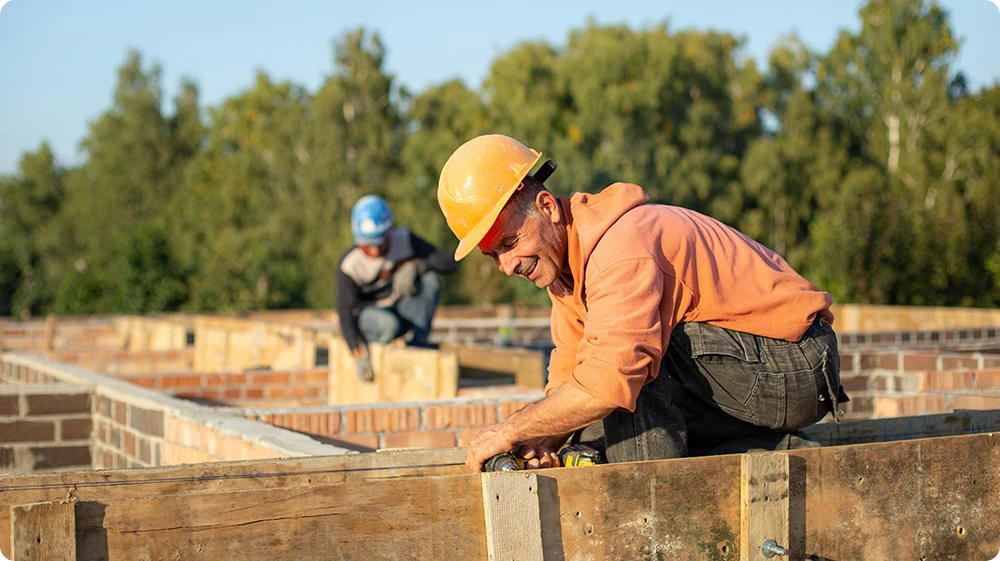Even the most experienced bricklayers make mistakes, especially when working under pressure. Whether it’s something as simple as misjudging mortar consistency or skipping key prep steps, small errors can quickly turn into big problems if left unchecked.
Here’s what you need to know about the most frequent issues in brickwork and how to get it right, from uneven brickwork to repointing issues, we’ll walk you through what to watch out for, how to correct poor habits, and why improving your technique matters for both quality and safety. Think of this as a quick check-in on what to avoid and how to maintain your bricklaying skills.

Why Avoiding Mistakes Matters
In bricklaying, precision isn’t just about appearances, it affects the strength, safety, and durability of the entire structure. Poor workmanship can compromise structural integrity, reduce weather resistance, and lead to long-term issues that require costly repairs. Even small errors, when repeated, can set you back professionally and result in rework. Whether you’re just starting out or have years of site experience, many bricklaying mistakes stem from the same causes: rushing, skipping important checks, or not fully understanding the process. The good news is that most of these can be avoided with the right knowledge and habits.
In the sections that follow, we’ll break down these common mistakes and show you how to fix, or better yet, avoid them altogether.
Incorrect mortar mixing
One of the most frequent issues is incorrect mortar mixing. Too much water, not enough cement, or inconsistent batches can all weaken the mix and cause premature cracking. Using clean materials and sticking to proper ratios is key. Mix in small batches so the mortar remains workable, and always pay attention to consistency, it’s the foundation of everything that follows.
Drainage and Clean-Up
While focusing on structure, many bricklayers overlook the importance of drainage or fail to remove excess mortar. Water trapped without proper drainage can slowly damage the wall from within, while dried mortar on bricks makes the finish look rushed and unprofessional. Always plan for water runoff and wipe away spills before they set.
Misaligned or uneven bricks
Another issue is misaligned or uneven brick courses. Even if you’re working quickly, it’s important to use a spirit level and string line frequently to keep things straight. A single slanted course can throw off an entire wall, leading to a finished product that looks unprofessional and may need reworking.
Skipping wall ties or reinforcement
Skipping wall ties or reinforcement is a structural mistake that can seriously weaken a wall, especially in cavity construction. It’s essential to check the building plans for tie spacing, embed them correctly, and ensure they’re aligned properly. Overlooking this step compromises the wall’s stability and longevity.
Leaving out expansion joints
Sometimes, it’s what you don’t include that causes problems like leaving out expansion joints. These small gaps are critical for absorbing movement caused by temperature changes or settling. Without them, walls can crack over time, especially on long or exposed surfaces.
Poor weather planning
Poor weather planning is another common pitfall. Cold, wet, or windy conditions can interfere with mortar setting and brick adhesion. Working in unsuitable weather or failing to protect fresh work can lead to frost damage or weakened bonds. Always check site conditions and be prepared to adapt; sometimes, waiting a day can save days of repair.
Improper joint tooling
When it comes to finishing, improper joint tooling, especially during repointing work, can lead to both aesthetic and functional issues. Tooling too early, leaving gaps, or applying uneven pressure can weaken the joint or lead to moisture ingress. The trick is to let the mortar cure slightly before striking, ensuring full, clean, and uniform joints.
Poor Repointing Techniques
Mistakes like raking out too deeply, using the wrong mortar mix, or striking too early can lead to weak joints and moisture ingress. If repointing is done poorly, the whole wall can deteriorate faster than it should. Read our full guide on Brickwork Repointing Mistakes and How to Get It Right
Ignoring drawings or building regulations
Ignoring drawings or building regulations is another common error that often leads to problems down the line. Misplacing damp-proof courses, getting cavity widths wrong, or misaligning openings can all result in failed inspections or the need for costly corrections. Double-checking plans before and during your build helps avoid these headaches.
Inconsistent perp joints
Inconsistent perp joints, the vertical gaps between bricks, may seem like a small detail, but they can make good brickwork look messy. Using gauges or spacers and taking the time to align each brick properly leads to a more professional finish.
Overworking laid bricks
There’s also the habit of overworking laid bricks. Tapping or adjusting bricks after placement might seem harmless, but it can break the mortar bond and reduce strength. It’s better to take your time placing the brick correctly the first time, instead of correcting it later.
Rushing the job
Finally, rushing the job is a mistake that leads to many of the issues listed above. From uneven courses to incomplete joints, trying to move too fast usually costs more time in the long run.
Bricklaying rewards a steady rhythm, one that comes from experience, not speed alone. If you want to work on UK construction sites, getting a CSCS card is essential for most bricklaying jobs. Here’s how to get your Bricklayer CSCS Card.
Turn Experience Into Certification and Lay the Foundation for Your Bricklaying Career
Already working on-site? Get officially recognised with the NVQ Level 2 in Bricklaying practical, respected, and built for professionals like you.
Ready to Lead and Take On Bigger Projects?
The NVQ Level 3 Diploma in Bricklaying is built for skilled tradespeople looking to move into supervisory roles, tackle complex builds, and grow their career in construction.
Conclusion
Bricklaying is as much about avoiding errors as it is about getting the basics right. From mixing mortar correctly to maintaining level brick courses, every decision on site impacts the strength, safety, and appearance of the final build. Mistakes like skipping expansion joints, repointing poorly, or misreading drawings can seem small in the moment but lead to significant consequences later.
The best bricklayers are those who keep learning, stay precise under pressure, and understand the “why” behind every task, not just the “how.”
Need Help Getting Your Bricklaying CSCS Card?
If you’re unsure about the process or need to book your NVQ Level 2 or 3 in Bricklaying, contact Hurak at 0333 344 1293.
We offer a wide range of trade-specific NVQs and provide full support with CSCS card applicationsFrequently Asked Questions on Bricklaying
Why is mortar mix consistency so important?
If your mortar is too wet or too dry, it won’t bond properly with the bricks. This can lead to weak joints, cracks, or crumbling over time. Always follow the recommended mix ratio and use clean, consistent materials.
What happens if you don’t use expansion joints in a wall?
Without expansion joints, brickwork can crack as it expands and contracts with temperature changes. They’re especially important in long or exposed walls.
How can weather impact bricklaying?
Wet, cold, or windy conditions can cause mortar to dry too slowly or too quickly, weakening the bond. It’s important to plan ahead and use protective covers or additives when needed.
How do I keep brickwork level and neat?
Use a string line, spirit level, and brick gauge consistently. It takes practice, but attention to detail is what separates neat, professional brickwork from amateur jobs.
Advance Your Career with These Popular Construction NVQs
Level 2 NVQs (Blue CSCS Card – Skilled Worker)
These are ideal if you’re early in your career or want to get formally recognised for your current skills:
- NVQ Level 2 in Bricklaying
- NVQ Level 2 in Stonemasonry
- NVQ Level 2 in Plastering
- NVQ Level 2 in Carpentry
- NVQ Level 2 in Wall and Floor Tiling
- NVQ Level 2 in Roofing Occupations
- NVQ Level 2 in Painting and Decorating
- NVQ Level 2 in Passive Fire Protection
Level 3 NVQs (Gold CSCS Card – Advanced Worker/Supervisor)
Perfect if you’re experienced and ready to lead on-site or take on complex projects:
- NVQ Level 3 in Bricklaying
- NVQ Level 3 in Stonemasonry – Banker Masonry
- NVQ Level 3 in Stonemasonry – Memorial Masonry
- NVQ Level 3 in Plastering
- NVQ Level 3 in Roofing Occupations
- NVQ Level 3 in Wall and Floor Tiling
- NVQ Level 3 in Painting and Decorating
Each of these NVQs can be completed through an on-site assessment, so you don’t have to stop working to qualify. Take the next step in your trade and stay competitive in the construction industry.



